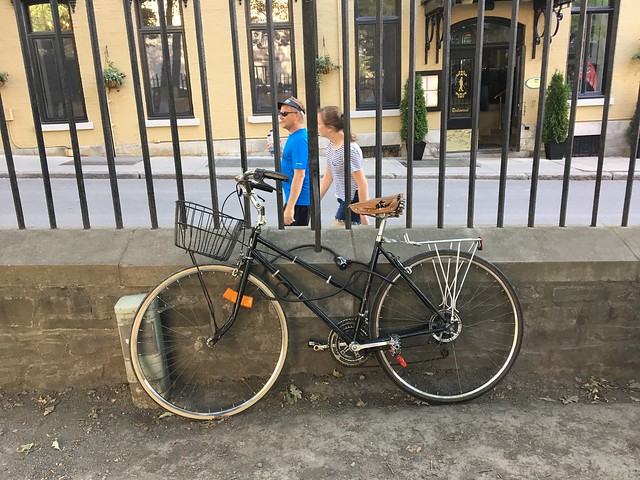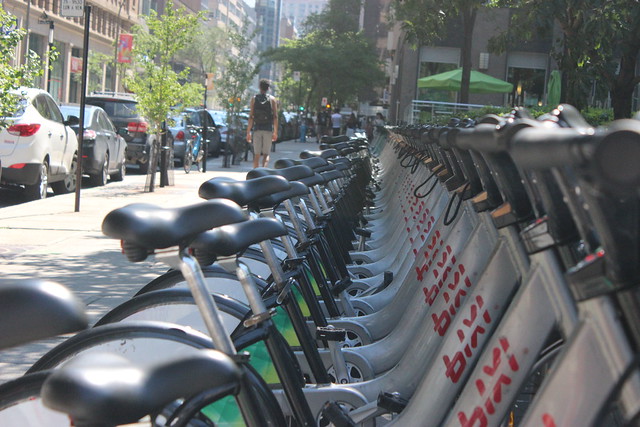There’s a scene in the 1942 Orson Welles film The Magnificent Ambersons that has some eerie parallels to today. The scene, set around the early part of the 20th century, is a confrontation between the maker of new-fangled “horseless carriages” (automobiles) and the old guard.
In the film, the automobile is a metaphor for the conflict between the old and the new, but watch the scene and think about the state of our cities today.
This monologue has particular resonance at this moment, because it feels like we’re in another of those periods of transformational transportation change. This time, it’s not the automobile replacing the horse, but the robots replacing the humans.
Autonomous cars are imminent, which seems to have created two competing visions for the future. The first, which has been gaining steam for the past 20 years, is defined by urbanism. It’s the future that most readers of this blog probably envision: less automobile-dependent streets where we focus on accommodating humans before cars. That means a grand rethinking of our streets and how we get around. More public transit, more cycling, more walking, and fewer cars. This is the vision that is driving change in many cities, from Paris to Copenhagen to Vancouver and Bogota.
But a competing vision has emerged in more recent years. This is a future that is built on technology, and its seductiveness is undeniable. Self-driving cars that arrive at your door to transport you to your smartphone-chosen destination. The end of car ownership in favour of transportation service. Fleets of robot cars roaming the streets to pick up and deliver people and packages.
These two visions don’t have to be at odds, but the closer we get to the realization of these visions, the more it seems they are. The promise of the first vision is a realignment of the transportation priorities of our cities, away from automobiles in favour of a more equitable balance between other modes.
The other, however, despite its promise, risks simply being a replacement of the status quo: swapping human-piloted vehicles for those driven by computers. Even the debate around this month’s tragic killing of a pedestrian by a self-driving Uber car comes down, fundamentally, to a debate over this vision. I’m in the camp that sees potential benefits to the technology, particularly the reduction of automobile collisions, but this isn’t a question of whether we use the technology or not. It’s about the fundamental problems of living in a society too reliant on automobiles—congestion, collisions, hostile streets and, despite our best intentions, deaths—may actually be exacerbated by this vision.
Think about congestion. In New York, for example, it has gotten worse in the last decade, not better, attributable mostly to the proliferation of ride-sharing services like Uber, which will no doubt grow as autonomous vehicles emerge. Filling the streets with empty vehicles on their way to pick up a fare is unlikely to reduce those fundamental problems. In London, the story is the same, as seen in this tweet:
Headline from @dailytelegraph, obviously intended to whip up support for more road space for cars, is actually a powerful argument for more people to ride bicycles, and to build more infrastructure for them, as a much cheaper, efficient, healthier & people friendly option. pic.twitter.com/fRAw3SFaqd
— Greg Vann (@GregVann) March 25, 2018
Both visions seem to have momentum these days, but even as the benefits of urbanism are increasingly accepted by the broader public, its a vision that’s expensive, sometimes contentious, inherently political and requires long-term thinking heavy on public input and taxpayer investment. It’s not easy.
The robot future, by contrast, seems to be arriving almost by the force of its own will. Enthusiasm for the technology has brought it to our doorstep with a sense of inevitability. In the same way we dove headlong into a world defined by Facebook before we started thinking about its impacts on our lives, our brains, our politics, our news and our children, our zeal for technology has brought robot cars to our door before we’ve really considered the implications of opening it.
The good news is that these visions needn’t be at odds. A better balance between automobiles and humans in our urban settings can no doubt be improved by driverless technology. In fact, the most prominent proponent of this driverless future, Tesla’s Elon Musk, who has seemed dismissive of transit and active transportation in the past, may be coming around. There is much skepticism around his vision for the future, but optimists may see this recent tweet as a sign that he is starting to see these two visions coming together.
Adjusting The Boring Company plan: all tunnels & Hyperloop will prioritize pedestrians & cyclists over cars
— Elon Musk (@elonmusk) March 9, 2018
But this coming together can only happen if we recognize that the future isn’t driven by inevitabilities and momentum. It’s created by the decisions we make. And now is the time to make those decisions for the future.
Thanks to Dave Cohen of VBike for opening my eyes to The Magnificent Ambersons.
Follow Shifter on Youtube, Facebook or Medium.
Follow Tom Babin on Twitter, Facebook or Medium.
Tom Babin is the author of Frostbike: The Joy, Pain and Numbness of Winter Cycling.




Lagatta de Montréal
I’m opposed to self-driving vehicles in the form of individual cars, but I think this could provide a public transport solution for smaller communities where a standard bus route might not be feasable.
Jordan Blake
We should prioritize pedestrian and cyclists in the inner cities, but that kind of change in mentality and physically change the infrastructure takes a LOT of time.
Julio
Nonetheless, if you bet persistently, then unfortunately you could possibly
drop everything you have gained.